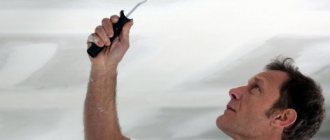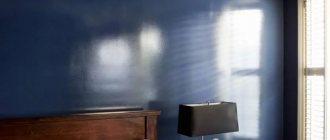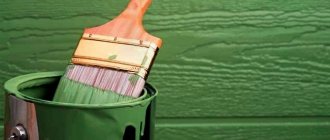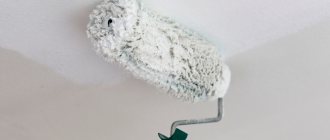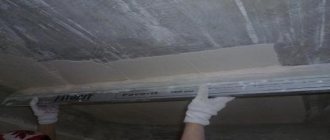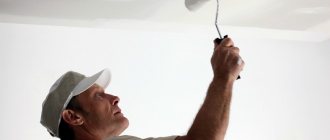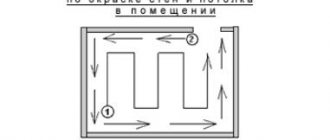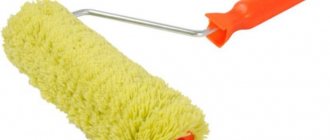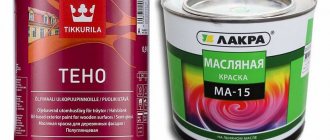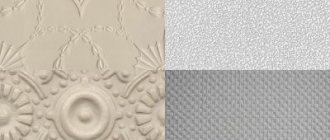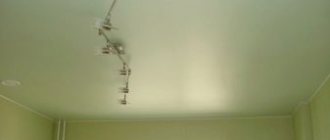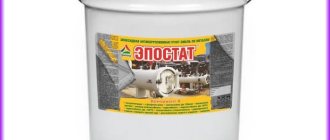Operating principle
Latex paint is a water-dispersion composition. That is, it includes not only the coloring pigment and binding polymers, but also water, which in this situation plays the role of a solvent. It does not allow particles to adhere to each other while the substance is in a liquid state. After application, the water begins to gradually evaporate, as a result of which the polymers form a stable, durable film on the surface.
Top 4. Dulux Ultra Resist Kitchen and Bathroom
Rating (2021): 4.23
31 reviews taken into account from resources: Yandex.Market, Otzovik, LeroyMerlin
The best protection against water and dirt After drying, a durable wax layer is formed that does not allow moisture to pass through and repels dirt. As a result, the coating practically does not get dirty and is easily washed even from greasy stains.
- Characteristics
Average price: 1810 rub.
- Country Russia
- Coating type: semi-matte
- Smell: medium
- Consumption: 12-15 m2/l
- Drying: 6 hours
- Volume: 2.25 l
Dulux Ultra Resist “Kitchen and Bathroom” has all the necessary qualities for a moisture-resistant mixture - it is not afraid of moisture, steam, is easy to clean, and is resistant to mold. If we compare it with other latex paints for the bathroom and kitchen, then in terms of water and dirt-repellent properties it surpasses many analogues. This is due to the fact that the composition contains wax, which, after drying, forms a durable impenetrable film. When opening the package, you may be confused by the pungent odor from the antifungal components, but this is not dangerous and the paint is completely harmless to health. The consumption is economical, and given the high cost, this is a very important point.
Advantages and disadvantages
- The composition contains wax, which forms a reliable film and increases water- and dirt-repellent properties.
- Easy to clean even from greasy stains
- Mold resistant
- Eco-friendly
- Economical consumption
- Very expensive
- There is a pungent smell
Main advantages and disadvantages
Latex paint has many beneficial advantages:
- After painting and complete drying, the surface is highly resistant to moisture. This is very convenient: if dirt appears, in most cases it can be easily cleaned without fear of damaging the coating. It is important not to use harsh abrasives or caustic chemicals for these purposes. In rooms where the ceiling inevitably gets dirty, for example in the kitchen, it is better to replace latex paint with silicone or silicate.
- The coating with this type of finishing material has vapor and waterproofing properties.
- The composition is very convenient to use. The drying time of one layer ranges from thirty minutes to two hours, depending on the humidity in the room and the thickness of the application. In addition, the substance does not have a characteristic odor, which is also very practical.
- The paint is highly elastic, thanks to this property you don’t have to worry about the ceiling becoming covered with cracks over time.
- Another important advantage of the coating is its ability to pass air. This means that the painted surface will “breathe” and will not form unsightly bubbles.
In addition to the listed advantages, latex paints also have some disadvantages:
- The increased elasticity of the composition leads to the fact that after painting, all irregularities, roughness and other flaws will be clearly visible on the ceiling. To avoid this, the surface must be thoroughly smoothed and sanded before application.
- Latex does not tolerate hypothermia. Substances based on it can only be used in rooms that are well heated. Otherwise, the coating will not stick to the ceiling.
- Paintwork materials of this type are very susceptible to mold, mildew and bacteria. Therefore, before you start applying them, you must treat the surface with a special antiseptic, and subsequently sanitize the room.
- The disadvantages include the low fire resistance of the composition.
What is the best tool to paint the ceiling?
Experts recommend using a special roller to paint the ceiling with latex paint, but we will now analyze which roller is best for applying the paint:
- Interior paint is ideally applied to the ceiling with a roller that has a fleecy base. Thanks to it, you can make all the irregularities almost invisible.
- When buying a roller with long pile, you need to check its quality. A high-quality roller will hold its pile securely, but otherwise all the fallen fibers will simply stick to the painted surface, which, naturally, will not make any surface attractive.
- Latex ceiling paint is applied evenly only with a thick roller. The tightness of the tool can be checked by squeezing it in your hand. If no deformation is detected during the compression process, then the tool is of high quality and you can safely buy it.
Rollers made from a velor or foam rubber base are available for sale, but buyers do not leave the best reviews of these models. Such models absorb much more paint material, so paint is wasted uneconomically. When working with such rollers, irregularities in the form of bubbles may form on the surface of the ceiling, and the latex base will constantly drain from the tool. Therefore, experts recommend using a roller with a fleecy base to paint the ceiling.
Main varieties
Modern latex paints are divided into several types:
- acrylic;
- acrylic butadiene-styrene;
- acrylic polyvinyl acetate;
- acrylic silicone.
Various types of coating are used for interior and exterior work. The composition of the paint used in the treatment of building facades includes special substances that provide protection against the formation of mold.
Paint and varnish materials that are intended for interior decoration are divided into acrylic, vinyl, textured, dense and dripless.
Thick and vinyl varieties are best suited for painting the ceiling. Textured compounds help create interesting raised designs, usually used when painting walls.
The simplest and most affordable option for latex paint is polyvinyl acetate, or, to put it simply, a water-based paint that provides a matte surface. Due to the high adhesion of the substance, the resulting coating is durable. In addition, the composition dries quickly and is practically odorless; it can be easily washed by hand.
The disadvantage is its ability to be washed off even after all layers have completely dried. But for painting the ceiling this is not particularly important. This option is not applicable for finishing a country house, since its durability decreases significantly when the temperature drops.
Stretch ceiling covering
Painting a stretch ceiling
Do you want to renew the tension surface, thus improving its external performance by painting? It is worth noting that these manipulations can only be done with tension materials that do not have connecting seams.
For this type of work, you should use an acrylic-based coating. Use a spray bottle to apply the composition to the surface. Experts do not recommend covering tension surfaces too often. The fact is that with each subsequent layer they increase in weight, which means that they will sag over time, which is, of course, undesirable. The conclusion is simple - you can cover tension structures no more than 5 times.
Experts do not recommend painting if you do not have at least some experience in this matter. This is due to the fact that even a professional is not able to maintain the gloss and gloss that the material had before processing. Having lost their gloss, tension surfaces attract dirt and dust more, which becomes more noticeable.
It is also important to take into account the fact that self-renewed tension surfaces, when using electric heating devices and when exposed to temperature changes, will begin to crack after a while and will not be attractive. In such a situation, of course, you can re-treat the surface, but the result of this manipulation will be short-lived.
If, for some reason, the tension structure has lost its attractiveness and needs restoration, then as an alternative, you can partially decorate it using airbrushing. You can make an imitation of the sky and clouds.
The combination of knowledge of coating technology along with high-quality primers and paints, and working tools is the key to a high-quality, reliable and beautiful coating. If you have experience in coating, then share it with us and our readers. Write comments at the end of this article.
Paint selection
To choose the ideal latex paint for ceiling decoration, you need to decide not only on its shade. An important parameter is the degree of gloss, which is divided into 6 categories. The lower the gloss number, the more matte the surface will be after drying.
A composition that provides an almost mirror-like finish is extremely rarely chosen, especially for walls. The most popular is considered to be a moderately matte paint.
It is also necessary to take into account parameters such as moisture and wear resistance. You can judge them using the abrasion cycle indicator, which is indicated on each package. The higher the number, the more durable the finish will be. Sometimes this characteristic is indicated in classes, the highest quality of which is the first class.
It is worth paying attention to two more parameters:
- Covering power refers to how much material is required for complete coloring without translucent areas.
- Thixotropy characterizes the rate at which paint thickens after it is applied to the surface. Based on this indicator, we can conclude how great the risk of streak formation is. With low thixotropy, streaks may occur during dyeing.
Top 5. DALI for kitchen and bathroom
Rating (2021): 4.14
26 reviews taken into account from resources: Otzovik, OZON
- Characteristics
Average price: 740 rub.
- Country Russia
- Coating type: matte
- Smell: medium
- Consumption: 10-12 m2/l
- Drying: 2 hours
- Volume: 2.5 l
Latex-acrylic paint with increased water resistance. Reliably covers walls and ceilings, but at the same time allows them to “breathe”. Bactericidal substances prevent the formation of mold and extend service life. At the same time, the smell from them, judging by the reviews, is not too strong and dissipates quickly. Wear resistance is also pleasing - if dirt gets on the painted wall or a greasy stain remains on it, all this can be easily removed with a wet rag. As a disadvantage, buyers highlight only the low coverage - to achieve a perfectly even shade, you will have to apply 3-4 layers.
Advantages and disadvantages
- The smell dissipates very quickly
- Bactericidal - protects against mold and mildew
- Optimal price
- Provides a “breathable” effect
- Does not absorb dirt and is easily washed from dirt and grease
- To achieve a perfectly even shade, you need to apply 3-4 layers.
Painting procedure
The dyeing technology is quite simple and does not require any special skills. The process consists of several stages:
- If no primer was used, the first layer is applied with diluted paint. The solvent can be either a special composition or plain water.
- The layer is applied using a roller. For convenience, you can first paint the edges with a brush - this way the paint will not get on the walls.
- The ceiling is left until completely dry.
- The next layer is performed without dilution. To do this, you can use either a brush and roller, or a sprayer. If you mix a little linseed oil into the composition, it will go on much smoother.
- Final drying should be carried out without drafts.
A competent choice and compliance with all rules is the key to successful repairs. By following the tips described, you can finish the ceiling without much difficulty.
Coloring technique
Preparing the base
As a rule, latex-based compositions are used for finishing walls and ceilings in rooms with high levels of humidity - bathtubs, combined bathrooms, kitchens, etc. Since the paint layer in such a situation is subject to serious influences, it is worth taking care in advance of high-quality preparation of the base.
Photos of defects requiring repair
The pre-processing technique includes a number of operations:
- At the first stage, we need to remove the old finish, namely wash off the plaster or clean off the paint. Of course, the characteristics of high-quality pigments allow them to be applied over a painted surface, but this should only be done in extreme cases.
- After removing the finish, we inspect the leveling plaster by tapping. We open the detected cavities, and remove weakly holding areas with a spatula.
- If the damage makes up a small part of the total ceiling area, then you can limit yourself to local repairs. Otherwise, it’s worth taking the time to plaster the floor again.
Advice! It is worth adding an antiseptic to the plaster mixture - this will prevent the development of fungus.
- After the plaster has completely dried, we grout it, and then putty the surface for painting. For finishing leveling, ready-made mixtures with a gypsum binder are best suited.
Surface putty
- Next you need to sand the ceiling. This is done either with a hand grater or with a special machine on which sandpaper is attached.
- For grinding, it is best to use abrasives No. 80-100: they do not clog so quickly, and the surface cleanliness is quite acceptable.
- In parallel with grouting, it is necessary to protect the communications running along it (pipes, ventilation ducts, etc.) from corrosion. For this purpose, electrically conductive Zinga paint or other insulating composition with an anti-corrosion effect can be used.
The ceiling must be sanded before painting
The preparation is completed by removing dust from the ceiling and applying a primer, preferably acrylate.
Ceiling treatment
The technology of applying latex compositions to the ceiling is not complicated and can be mastered directly in the process:
- If the base has not been primed, then apply the first layer of paint after liquid dilution. Either water or emulsion thinners can be used as a solvent.
Note! When using special compounds, the color may darken. So you need to take this factor into account when planning your work.
- We put the diluted paint on a roller and apply it to the ceiling. To avoid drops getting on the walls, you can apply a strip about 5-10 cm wide along the perimeter with a brush - it will act as a kind of border.
The perimeter line acts as a kind of border
- After painting is completed, thoroughly dry the base layer. It is desirable that by the time the second pass begins it has completely lost its stickiness.
- The second time we paint the ceiling with thicker paint (with a dilution of about 10% or without it at all). In this case, the composition can be applied either with a brush or roller, or with a spray.
- If you use a hand tool, you can add a small amount of linseed oil to the pigment. After thorough mixing, the paint with the modifier goes on much more evenly.
- When applying it is worth using a lamp for side lighting. Rays directed along the strokes will allow you to identify and eliminate all defects in advance.
Paint the entire surface in several layers
Advice! If there is no lamp, then the finishing layer must be applied, moving from the window of the room to the wall.
As we noted earlier, latex has a very negative attitude towards hypothermia. That is why the ceiling must be dried at a temperature not lower than 100 C, and preferably in the complete absence of drafts.
Manufacturers of latex and silicone ceiling paints
Among the most popular paint manufacturers on the building materials market are:
- Caparol. A German company with a well-organized network of distributors and branches in different countries. The range of products manufactured by the company is quite wide. Silicone paints, which are of good quality, deserve special attention.
- Dufa. This German manufacturing concern has its representative offices in more than 20 countries. A special feature of the products is the presence in the line of coatings with a textured pattern.
- Dulux. This centuries-old English company prides itself on its cutting-edge technology and innovative solutions.
- Snowball. This Polish manufacturing company has been persistently making its way into foreign markets in recent years thanks to the acceptable price-quality ratio of the product.
- A Swedish company that produces acrylic and matte latex paints for walls and ceilings that do not run down the surface and adhere well.
- A Finnish company that has long been firmly established in the world market. The manufacturer has developed a special series for wooden surfaces, and the color range of the products includes about two hundred shades.
- The domestic manufacturer offers a wide selection of facade paints on the market. Among them, it is worth noting environmentally friendly acrylic, as well as textured facade ones, which can well mask surface unevenness.
Important! Despite the rather high pricing policy of well-known manufacturing companies, the difference in price compared to cheaper options is compensated by high quality and durability, as well as low material consumption per square meter.
